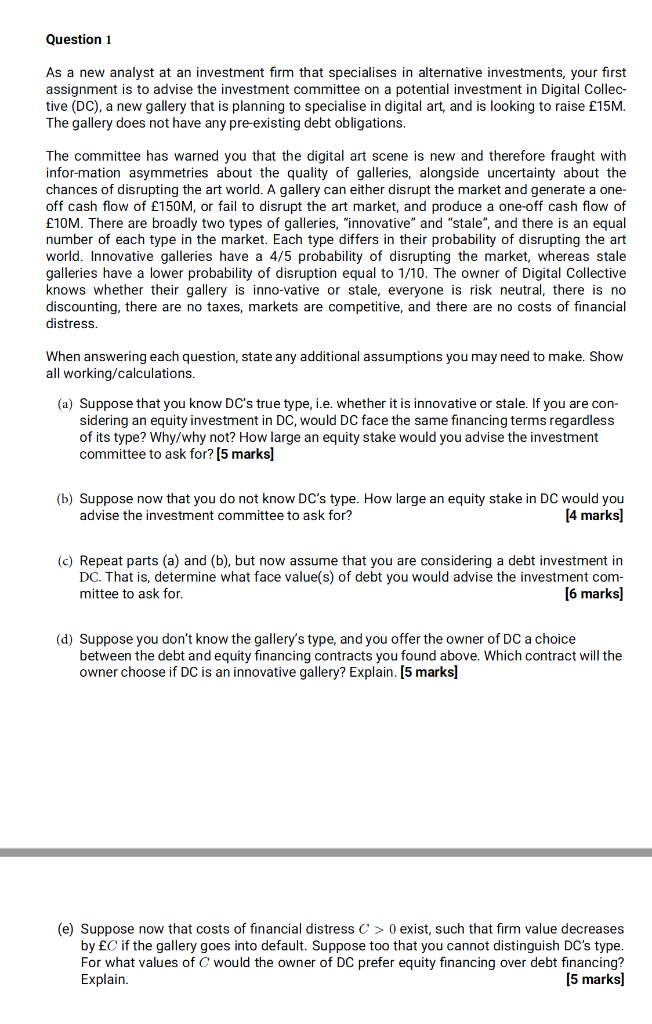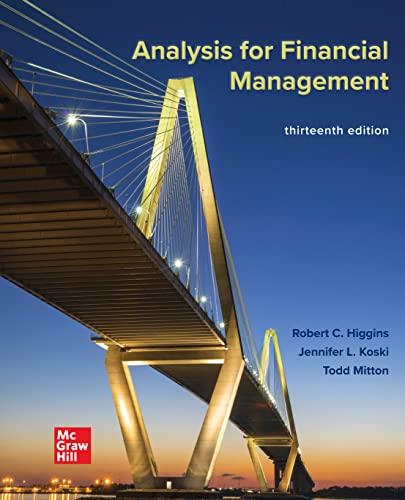Question
As a new analyst at an investment rm that specialises in alternative investments, your rst assignment is to advise the investment committee on a potential
 As a new analyst at an investment rm that specialises in alternative investments, your rst
As a new analyst at an investment rm that specialises in alternative investments, your rst
assignment is to advise the investment committee on a potential investment in Digital Collective
(DC), a new gallery that is planning to specialise in digital art, and is looking to raise 15M.
The gallery does not have any pre-existing debt obligations.
The committee has warned you that the digital art scene is new and therefore fraught with information
asymmetries about the quality of galleries, alongside uncertainty about the chances of
disrupting the art world. A gallery can either disrupt the market and generate a one-off cash ow
of 150M, or fail to disrupt the art market, and produce a one-off cash ow of 10M. There are
broadly two types of galleries, innovative and stale, and there is an equal number of each type
in the market. Each type differs in their probability of disrupting the art world. Innovative galleries
have a 4/5 probability of disrupting the market, whereas stale galleries have a lower probability
of disruption equal to 1/10. The owner of Digital Collective knows whether their gallery is innovative
or stale, everyone is risk-neutral, there is no discounting, there are no taxes, markets are
competitive, and there are no costs of financial distress.
When answering each question, state any additional assumptions you may need to make. Show
all working/calculations.
(a) Suppose that you know DCs true type, i.e. whether it is innovative or stale. If you are considering
an equity investment in DC, would DC face the same nancing terms regardless
of its type? Why/why not? How large an equity stake would you advise the investment
committee to ask for? [5 marks]
(b) Suppose now that you do not know DCs type. How large an equity stake in DC would you
advise the investment committee to ask for? [4 marks]
(c) Repeat parts (a) and (b), but now assume that you are considering a debt investment in
DC. That is, determine what face value(s) of debt you would advise the investment committee
to ask for. [6 marks]
(d) Suppose you dont know the gallerys type, and you offer the owner of DC a choice between
the debt and equity nancing contracts you found above. Which contract will the owner
choose if DC is an innovative gallery? Explain. [5 marks]
(e) Suppose now that costs of financial distress C > 0 exist, such that rm value decreases
by C if the gallery goes into default. Suppose too that you cannot distinguish DCs type.
For what values of C would the owner of DC prefer equity nancing over debt nancing?
Explain. [5 marks]
Question 1 As a new analyst at an investment firm that specialises in alternative investments, your first assignment is to advise the investment committee on a potential investment in Digital Collec- tive (DC), a new gallery that is planning to specialise in digital art, and is looking to raise 15M. The gallery does not have any pre-existing debt obligations. The committee has warned you that the digital art scene is new and therefore fraught with infor-mation asymmetries about the quality of galleries, alongside uncertainty about the chances of disrupting the art world. A gallery can either disrupt the market and generate a one- off cash flow of 150M, or fail to disrupt the art market, and produce a one-off cash flow of 10M. There are broadly two types of galleries, "innovative" and "stale", and there is an equal number of each type in the market. Each type differs in their probability of disrupting the art world. Innovative galleries have a 4/5 probability of disrupting the market, whereas stale galleries have a lower probability of disruption equal to 1/10. The owner of Digital Collective knows whether their gallery is innovative or stale, everyone is risk neutral, there is no discounting, there are no taxes, markets are competitive, and there are no costs of financial distress. When answering each question, state any additional assumptions you may need to make. Show all working/calculations. (a) Suppose that you know DC's true type, i.e. whether it is innovative or stale. If you are con- sidering an equity investment in DC, would DC face the same financing terms regardless of its type? Why/why not? How large an equity stake would you advise the investment committee to ask for? [5 marks] (b) Suppose now that you do not know DC's type. How large an equity stake in DC would you advise the investment committee to ask for? (4 marks] (c) Repeat parts (a) and (b), but now assume that you are considering a debt investment in DC. That is, determine what face value(s) of debt you would advise the investment com- mittee to ask for. [6 marks] (d) Suppose you don't know the gallery's type, and you offer the owner of DC a choice between the debt and equity financing contracts you found above. Which contract will the owner choose if DC is an innovative gallery? Explain. (5 marks] (e) Suppose now that costs of financial distress C > 0 exist, such that firm value decreases by C if the gallery goes into default. Suppose too that you cannot distinguish DC's type. For what values of C would the owner of DC prefer equity financing over debt financing? ExplainStep by Step Solution
There are 3 Steps involved in it
Step: 1

Get Instant Access to Expert-Tailored Solutions
See step-by-step solutions with expert insights and AI powered tools for academic success
Step: 2

Step: 3

Ace Your Homework with AI
Get the answers you need in no time with our AI-driven, step-by-step assistance
Get Started


